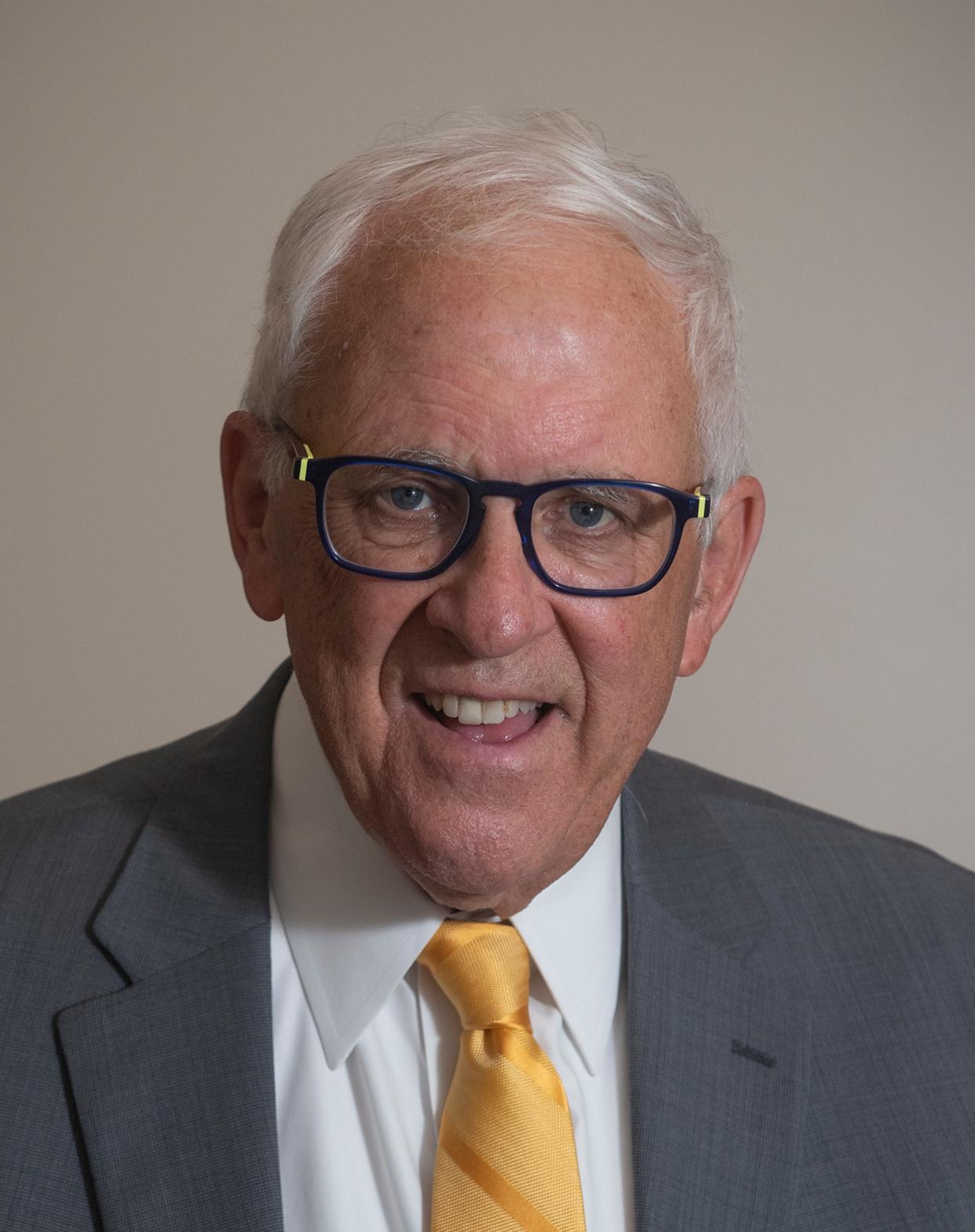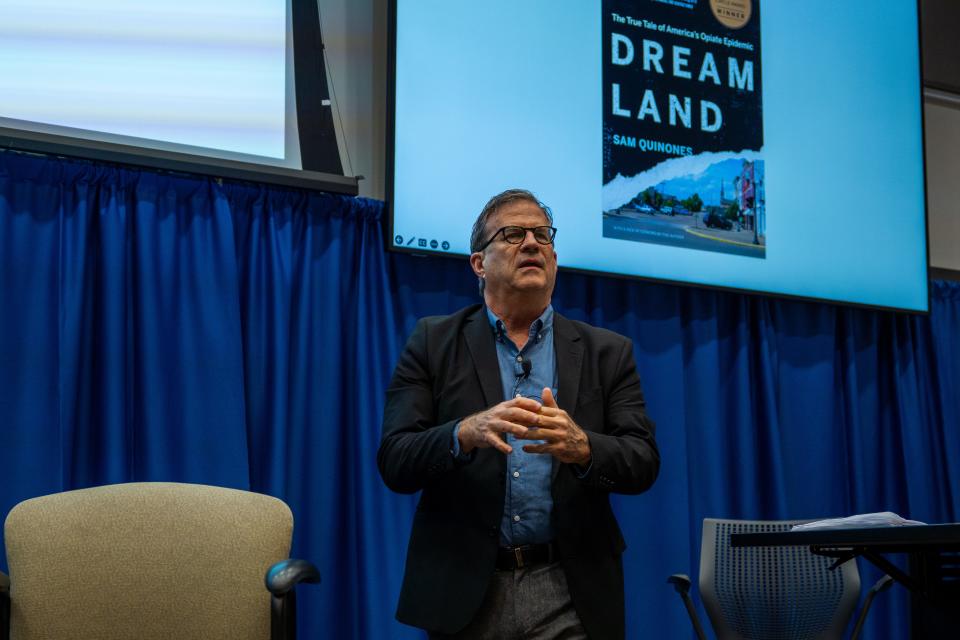KSU ethics lecturer reports drug trade growing deadlier | Along the Way

- Oops!Something went wrong.Please try again later.
The decline of traditional newspapers in the digital age has meant that stories of ordinary people are not reported as often.
Journalist Sam Quinones maintains they remain important and need to be told.
Quinones, the recent ethics lecturer at Kent State University’s School of Media and Journalism, advised students to tell those stories respectfully and accurately even if it means going back to the people interviewed and showing them one’s copy, to make sure of its accuracy.
Along the Way: The musical legacy of Germaine Williams
“These are stories of ordinary people, not CEOs with public relations departments,” he said. “We owe them accuracy.”

Quinones, a journalist with more than 30 years of experience, has made a career out of interviewing ordinary people, specifically those affected by America’s drug crisis. At first, he said, the people he interviewed were reluctant to talk, ashamed that they or loved ones were addicted.
However, as the addiction problem of the 1990s and 2000s grew, with millions of Americans becoming hooked on legitimate painkillers prescribed by doctors and hospitals, the stigma has eased, Quinones said.
During those years, big pharmaceutical owners like the Sackler Family, foreseeing profits in the billions, assured doctors their pain killers were not addictive. So assured, doctors prescribed large numbers of pain-killers. Quinones said addicts began to “doctor shop,” seeking more pills than their doctors might be willing to prescribe. They doubled or tripled their prescriptions. What they could not use, they sold for cash to other addictions, to such drugs as heroin and cocaine.
Meanwhile, as America’s opioid crisis multiplied, entrepreneurial Mexicans identified opportunity in small- and medium-sized heartland towns, where the organized crime of the big cities wasn’t a concern.
Along the Way: David Myers, Larry Lohman forge Kent Rotary milestones
Many of Quinones’ stories focus on small towns in Ohio.
Using technology available with cellphones, drug traffickers moved in and set up distribution systems much like pizza delivery companies have done, accepting call-ins and offering home delivery. When authorities cracked down and limited the sale of prescription painkillers, addicts simply broadened their purchases to include illegal drugs conveniently dropped off at their homes.
Athletes with painful injuries, people in pain because of accidents, veterans scarred by war, and even doctors who self-prescribed to boost their energy – all became members of a fast-growing customer base ready to spend their own money, money borrowed, or money stolen to feed their drug habit.
Quinones has written best-selling books and articles telling stories derived from his interviews with hundreds of addicts and their loved ones who became collateral damage.
“Dreamland,” published in 2015, describes the convergence of prescription pain killers and illegal narcotics. A best-seller, it won the National Critics Circle Award.
His frightening follow-up, “The Least of Us,” published in 2021, tells of the transformation of drug trafficking in America beginning around 2015 and 2016 from plant-based drugs into synthetically manufactured drugs created out of chemicals easily purchased over the Internet.
Fentanyl, an extremely addictive drug that often results in death, has become the drug of choice, Quinones writes. Tasteless and odorless, fentanyl in small doses spikes up heroin, cocaine and other drugs. It can be mixed into candy and pills that can be made to look like brand-name products. Also in demand is methamphetamine, which functions as an upper. Synthetically manufactured, it can cause brain damage and eventually kill. Laced with fentanyl, methamphetamines often kills instantly.
Quinones said NAFTA, the North American Free Trade Agreement, facilitates the drug trade. Manufacturers conceal their illegal drugs in appliances and other goods made in Mexico that truckers transport into the USA. We Americans, he said, have reciprocated by making guns, particularly automatic weapons, easy for drug manufacturers to buy. Weaponized, they defend themselves against Mexican police and bribe authorities who otherwise might try to shut them down.
He said we Americans and the Mexicans have unwittingly created a nearly “perfect ecology” for drug trafficking.
In small dinner sessions, Quinones and representatives of local government and health agencies discussed addiction trends. Locally, the trend is up. The upward trend is not a straight line, but figures from the office of Portage County Coroner Dr. Dean DePerro show 27 drug related deaths in 2014. Deaths rose over the years, to the 40s and reaching 51 a year by 2022.
DePerro recently reported that Portage County logged 12 drug-related deaths within 28 days this year. That puts the county on a pace that, if sustained, would result in more than 100 drug related deaths in 2024.
At one of the Kent State sessions, Common Pleas Court Judge Becky Doherty said her drug court, incentivizing abstinence, is making progress. “But it is slow-going and hard,” she added.
Portage County Prosecutor Vic Vigluicci, who serves on the Ohio Organized Crime Investigations Commission, said he recently toured America’s southern border in the Tijuana area. Photos he shared showed an American side of the border as park-like and green, while the Mexican side was a shanty town with shacks where people struggle for a living.
I emerged from all this realizing I had no idea of the power of drug addiction or how it induces the addicted to lie, steal, cheat or kill to obtain drugs.
Quinones warned that drug trafficking will worsen until the leaders of both Mexico and the USA make shutting it down their highest priority. Supply and availability are increasing demand, he warned. Quinones said he hopes a new Mexican president shows more interest in attacking the problem.
David E. Dix is a former publisher of the Record-Courier.
This article originally appeared on The Alliance Review: Journalist Sam Quinones updates KSU students on worsening drug trade

